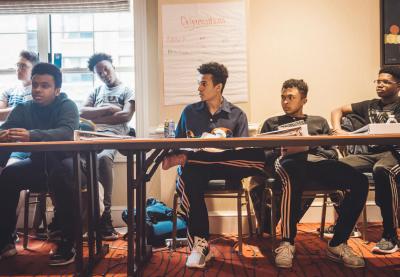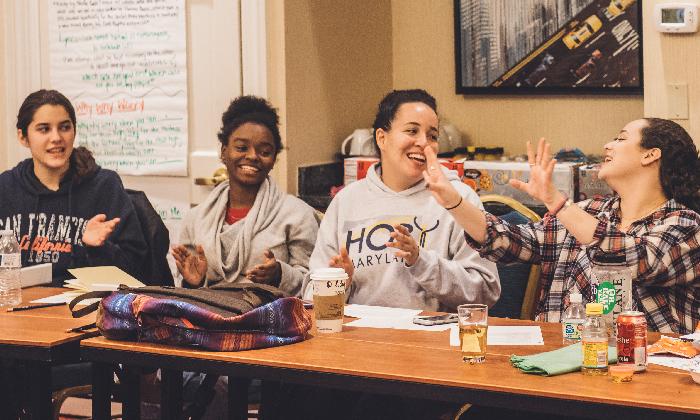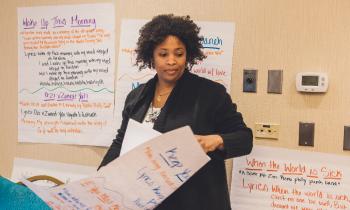On a brisk Saturday morning in April, the students of Operation Understanding DC (OUDC) crowd a messy hotel conference room, hard at work. Markers and poster board are strewn about, along with junk food to fuel discussions about the intersection of race and religion. Two-dozen teenagers are acting out skits and designing games and posters for their presentations on leaders of the civil rights movement. Several students huddle to practice a rap they’ve written about the Montgomery Improvement Association:
We have a broken system and we’re looking for improvement/
The racists wanna stop us but we keep movin’/
We want our equal rights ‘cause we are all just human/
Up in Alabama in 1955/
They tried to keep us down but we wouldn’t ever hide/
Boycotts, resistance, civil disobedience/
Fighting ideologies of local segregationists
The cramped conference room buzzes with laughter and debate as students put the finishing touches on their projects.
Since 1993, Operation Understanding DC has brought together a group of high school juniors in the Washington, D.C., metro region — half are African-American and half are Jewish — for a year of cross-cultural exploration. The civil rights retreat is one opportunity for students to discover the ways their backgrounds overlap, and how, together, they can overcome discrimination on all fronts.
“I think the black and Jewish experience is the foundation for future growth,” Executive Director Yolanda Savage-Narva says. The theme of black-Jewish resistance is underscored throughout the weekend with activities that highlight the unity of two oppressed peoples during the civil rights movement.
The students learn over the course of the retreat that it was a group of young Jewish and black civil-rights workers, Andrew Goodman, Michael Schwerner and James Chaney, who were murdered during Freedom Summer in 1964. It was the collaboration of black and Jewish leaders that led to the creation of the National Association for the Advancement of Colored People (NAACP) in 1909. Time and time again, the students learn, black and Jewish people have stood together in the face of adversity.
Aside from this retreat, during the spring, the students of “Class 23” take part in a home exchange for Easter and Passover. In a few months, they will embark on a Summer Journey through the Deep South, continuing their education on civil rights from the past to the present.
“We’re two very different cultures, but at the same time, not,” says student Julian Dowell. “As minorities and as oppressed groups, there’s always going to be commonalities between us. So coming to OUDC, I’ve been able to find those and just connect.”
Dowell says it’s the small moments that show students how they are more alike than different. After programs finish for the day, black and Jewish students go back to their hotel rooms, chatting about the everyday experiences that bond them.
“There’s just little things, like when you’re up in your room up at night talking, like, ‘Oh you go through that?’ It’s like, ‘Yeah, I go through that.’ Those are the most important moments in my opinion,” Dowell says.
Program Director Ricki Horne understands the power of conversation in shaping personal views. An OUDC alumna, Horne was moved by the discussions her sister, who was the first in her family to participate in the program, would spark at the dinner table. That led Horne to reflect on her own “privilege” and how she unwittingly took part in systemic forms of oppression.
There’s a saying at OUDC that sums up the program experience, according to Horne. “The relational is transformational,” she explains. “Once you’ve built that connection with another human, you can overcome a lot.”
Civil rights-era activist Joan Mulholland brings up issues of power and privilege in a Saturday afternoon presentation, wearing a T-shirt that commemorates the nine black people who were killed at Emanuel African Methodist Episcopal Church in Charleston, South Carolina, in 2015. Readers who don’t know Mulholland by name may have seen an image of her from 1963: a white woman, her face turned away from the camera, sitting in between Anne Moody and Hunter Gray at a Woolworth’s lunch counter in Jackson, Mississippi. The student activists are covered in food that’s been dumped on them by the surrounding mob.
The students are enthralled by Mulholland’s presentation, and many go up to hug and thank her afterward. One of those students is Sydney Smith, who says she was touched by Mulholland’s courage to resist a racist society, even though the injustices she witnessed had little bearing on her own life.
“So many people feel like, ‘Oh I’m not oppressed, I don’t really have anything to do with this,’ but you do,” Smith says. “And Joan is the perfect example of how someone who’s in a position of power can really make a difference and stand with people who don’t have a voice.”
It’s that attitude that Rhema Jones had in mind when applying for OUDC.
“I said it in my interview that I really wanted to be brave. I really wanted to stand up for people who can’t…even when it’s hard,” Jones says. ”By the end of the program, I want to be wiser and able to create change.”
To work toward progress, students must confront their own power and privilege, they are taught. An OUDC tradition is the “privilege walk,” an exercise that shows students where they literally stand in terms of their advantages in life. The students form a straight line side by side. Horne calls out a statement, and students take steps forward or backward in response. “I attend a private school” is a step forward. “I have gone to bed hungry because there was no food at home” is a step backward. After about 15 minutes, there is a stark distance between the student who stands at the front and the one who stands at the back.
After the walk, some students are visibly upset. Horne gathers the students in a circle on the floor of the hotel conference room, first to inhale and exhale deeply, shaking off the intensity of the walk. The discussion that follows is occasionally awkward, sometimes heated and peppered with snaps of approval.
Discomfort is part of the OUDC experience, says Ella Buring. And with an embrace of discomfort comes the ability to respect other people’s realities. “Commit to not being comfortable, and you will be exposed to other viewpoints,” Buring says. “That does not mean that everyone’s going to walk out thinking the exact same thing.”
OUDC offers a safe space to engage in heavy discourse “because all of those social barriers sort of disappear here,” she says.
They want to bridge the barriers that continue to divide, one lesson and one conversation at a time.
And social barriers do seem to evaporate when the students lead Shabbat and Havdalah services on Friday and Saturday night, respectively, and a sermon followed by upbeat gospel music on Sunday. There’s a lot of hugging, which Buring says is not uncommon within OUDC.
The students cherish these moments, as they rarely come up organically in daily life. Ben Vardi says that while his college-prep school is fairly diverse, most interactions don’t go beyond the surface.
“I think that it’s really important that we do expose more people to more situations, and I think the best way to do that is through education,” he says.
The timing of the civil rights retreat is not lost among the students, some of whom openly express their fears about living in such a volatile political climate. Black and Jewish students alike are no strangers to the intensifying racism and anti-Semitism throughout the country.
It can be challenging to find common ground across cultures, but that is exactly what is needed right now, Dowell says.
“I think right now it’s all about listening,” he says. “Even our community rule is listening to hear and not to respond. And I think that that’s what we don’t necessarily do nowadays. Everyone’s so quick to respond, ’cause everyone’s so opinionated.”
The students of OUDC are certainly opinionated, but they didn’t commit to a year of extracurricular activity to talk over one another. They want to bridge the barriers that continue to divide, one lesson and one conversation at a time.




0 COMMENTS